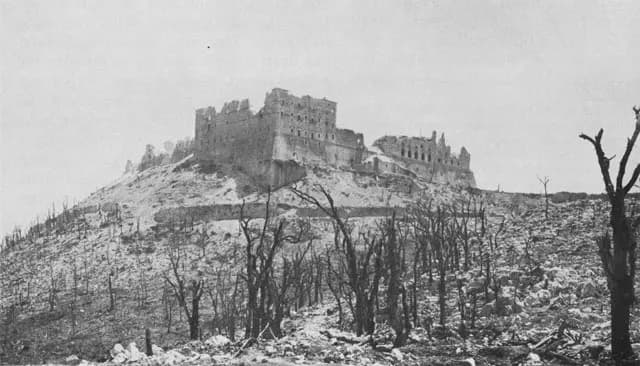ROME – A newly discovered document in the Vatican Archives suggests that a more energetic response from Vatican officials eighty years ago might have prevented the deadly Allied bombing of the historic Benedictine monastery of Monte Cassino on Feb. 15, 1944.
According to tradition, the monastery was established by St. Benedict himself in 529, and it was for the monks of Monte Cassino for whom Benedict penned his famous rule.
As is well known, during the Allied invasion of Italy in 1944, the area around the monastery became a focal point of the fighting due to its strategic position overlooking nearby valleys. At the peak of the battle, some 1,000 civilians took refuge in the monastery, believing – incorrectly, as it turns out – that it would be spared.
Instead, American and British forces concluded that German troops were using the monastery to launch mortar attacks on their forces, and thus unleashed some 1,400 tons of explosives on it, killing roughly 250 of the 1,000 people who had sought shelter there.
The day before the bombing, Allies forces dropped leaflets over the monastery urging non-combatants to leave. Some experts, however, regard that warning as fairly hollow, given that fighting was raging all around the area and no truce had been agreed upon to provide civilians safe passage.
The bombing of Monte Cassino became the most controversial moment in the Italian campaign, with many historians and military analysts debating during the decades since whether the carnage might have been avoided. General Mark Clark, who commanded American forces in Italy, once called the bombing a “tragic error.”
Recently, a longtime Italian journalist named Nando Tasciotti, now retired from the Roman daily Il Messaggero, uncovered a document which suggests that had the Vatican used its political and diplomatic influence to insist that German forces respect a theoretical neutral zone around the monastery, things might have played out differently.
Prior to the battle of Monte Cassino, both the Allies and the Germans had promised the Vatican that the monastery would not be attacked or used for military purposes. Nevertheless, German forces established positions inside an agreed-upon 330-yard radius and eventually took down signs declaring the space neutral.
In the four-page document unearthed by Tasciotti, which was written shortly after the liberation of Rome in June 1944, then-Monsignor Armando Lombardi, then an official of the Vatican’s Secretariat of State, wrote that the Vatican had received warnings that the Germans were ignoring the neutral zone but didn’t do anything about it.
“One has the impression that after the first 10 days of January [1944], i.e., during the most critical period, the Secretariat of State took no interest in the matter,” Lombardi wrote.
Lombardi, who would later be named an archbishop and appointed the papal ambassador to Venezuela and Brazil, suggested that had the Vatican used its leverage, the bombing might have been avoided.
“Those who are now studying the question calmly are inclined to believe that the monastery could perhaps have been saved if the principle of the neutral zone had been accepted and respected by both belligerents. With an energetic action, the Holy See could perhaps have obtained this,” he wrote.
The letter also contains a reference to the abbot of Monte Cassino at the time, Bishop Gregorio Diamare, who relayed a conversation he’d had with a German captain who told him that it had been Hitler himself who ordered that Monte Cassino be raised to “fortress strength,” effectively repealing the neutral zone.
So far, the Vatican has not made any comment on the newly discovered memorandum.
Tasciotti told the London Guardian that the failure to intervene to defend Monte Cassino reflected the broader ineffectiveness of what he called the Vatican’s “telegram diplomacy” of the era, referring to a tendency to lodge official protests after the fact rather than to intervene personally before tragedies occurred.
Though virtually destroyed by the bombing, the monastery of Monte Cassino was rebuilt after the war and remains a popular tourist and pilgrimage destination, as well as home to a small Benedictine community. Surrounding military cemeteries contain the remains of some 50,000 troops who died in the fighting, both Allies and Germans.













